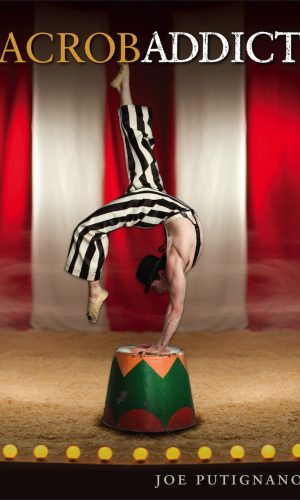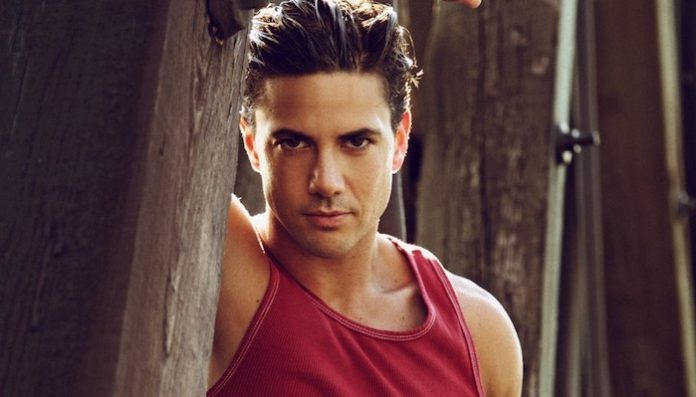
“I was training to become a contortionist and detoxing from heroin at the same time — I don’t recommend that to anyone. Ever. At all.”
That pretty much sums the dogged, no-nonsense and humorous spirit of 36-year old gymnast/performer/model and now author, Joe Putignano.
Heroin? Contortionist? Model? It’s a dichotomy that’s only likely to play itself out in the most outrageous Lifetime movie specials. So, to hear Putignano’s story — a promising pre-teen gymnast from Raynham, Massachusetts, who went on to endure nearly 15 years of extreme drug use and endless bouts of rehab, only to finally take the stage for a late-career comeback in his 30s as a Cirque du Soleil performer — is quite inspiring if not fantastical.
Putignano recently took a hiatus from the stage and, although six years clean, was forced to face his demons again: in March, he was in Atlanta recuperating from surgery to correct a superior labral tear in his shoulder which, among various other localized injuries, was caused by more than five years and nearly 1,000 performances in Cirque’s Totem. The surgery was successful, but, for someone with Putignano’s relapse rap sheet, rehab would need to be narc-free, a must for someone who has used as much as him.
“[The recovery] has been different. The surgery can be extremely painful, so I was really freaked out by what I read,” he explained to Boston Spirit. “But I go to a lot of meetings, and I did a lot of acupuncture. And just the support from other people has been remarkable.”
Managing pain is a cornerstone of Putignano’s story; a lack of support, early on, from those closest to him, also figures into his current editing project, Accrobadiction, a memoir slated for a September release and a subsequent book tour before a yet-to-be arranged return to Cirque.
“It’s about addiction and athletics. They both deal in obsession, and both are very compulsive, and, in my case, intertwined,” says Putignano. “Gymnastics allowed me to be a better drug addict because I could endure the pain and torture of insane detoxes. I know it sounds strange, but I was a successful, functional addict because I endured so much pain from endless training.”
Emotional pain came early for Putignano who was eight when he realized that he wanted to be a world-class gymnast while watching the 1984 Olympics. “I was hooked,” he says. “Like when a musician hears classical piano for the first time. I immediately took the cushions off the couch to jump around and do what I saw on TV.”
But by the time he started high school and after years of training, he knew that, while very good, he didn’t have what it takes for the brass ring, a shot at the Olympics. It didn’t help, he says, that he lacked the support of friends and family, the former suffering from substance abuse issues themselves. The rejection contributed to a fast and furious segue into a culture of super highs and plunging lows.
During his teens, a typical night out in Boston consisted of being “completely immersed in drugs” with his then-girlfriend usually at an all-ages night at Axis or traveling to one of the ubiquitous raves that dotted New England in the early ‘90s. All the while, he dabbled in gymnastics and managed to eke out a training routine for a future he couldn’t quite articulate but desperately wanted to achieve. He briefly attempted to re-enter the world of athletics when he enrolled in Springfield College.
“I was fighting both sides. When you do something with all that discipline, it doesn’t leave you even if you don’t want it to. To be honest, I really WANTED to lose the desire to perform because, when you hold onto something like that, it eats at you and causes a lot of depression and anxiety,” he recalls. “Ironically, the drugs suppressed all that and made me feel OK that I didn’t get to the Olympics, or OK that I wasn’t the best.
“In college, I did try to make it work, but there was that one moment when I made the decision to choose drug addiction over gymnastics. It was really sad. Like a musician smashing an instrument.” He says that in college he also came out. But the event occurred with little fanfare. “I think I just ended up bringing someone home with me and that was it.”
By 1999, New York City beckoned, and it wasn’t long before Putignano spiraled deeper into addiction and dysfunction: while working on editorial projects as a staffer at The New York Times, he was simultaneously dating a heroin addict with whom he developed a penchant for his partner’s drug of choice. Looking back, he says heroin ironically saved his life at a time when many gay substance abusers were adopting a differently potent powder.
“I did crystal at one rave and never understood why people took it. It boggled my mind. I never did crystal. I never did the club scene. I never did Manhunt … I never knew it existed,” he laughs. “Heroin is a very lonely drug. It’s not a social thing, and it really protected me from the unsafe sex. Face it; no man can do what heroin can do. So, what’s the point? Yeah, it kinda saved my life.”
Mostly. Overdoses caused at least two death pronouncements and a litany of rehabilitations during the years after ‘99.
By the mid-2000s, Putignano had hit rock bottom. He had convinced himself that he would never do gymnastics again, he hadn’t trained in years, and he was a stereotypical junkie: emaciated, visible tracks, and a body covered in piercings. He couldn’t bear to see gymnasts on TV. In fact, things were reaching a point of no return when, at one particular rehab, he was assigned to “an incredible counselor who said stuff that would bypass my brain and go straight into my heart.”
“I had this idea: what if I just go back to gymnastics without being competitive, because I feel like I’m on fire when I’m flipping,” he says.
A regimen of power push-ups and some coaxing from his roommates in rehab led to a failed audition for a Broadway show. “For an addict to get rejection that early in sobriety really sucks,” he recalls. “But, I realized that I wasn’t that far away even though I was skinny, I had every part of my body pierced, and the guys I was competing against were the most disciplined, healthy-looking New York City dancers you can imagine.”
Putignano’s luck had seemingly turned. Around the clock exercising and a new boyfriend, a dancer in Cirque’s Zumanity, rekindled his desire to get clean and to get back on the stage. Still at the Times, rather than spending his lunch breaks cooking and shooting powder, he’d stack boxes full of Xerox paper and stretch out the copy room. As with many addicts, relapses did occur, but they were brief compared to earlier falls from the wagon. In fact, he at one point added to his regimen an experimental drug that blocked the effects of opiates. “I was fucking pissed when I shot $100 into my arm and nothing happened,” he remembers.
He credits the success of the drug to a lasting rehabilitation that led to “getting his head back on straight,” stints on the stage, and the start of a side-career in modeling. However, the real break came when he was selected by choreographer Twyla Tharp to perform in her Broadway show The Times They Are A Changin,’.
“That’s what finally gave me enough self esteem to say, ‘OK, give this a chance. I know you’re in pain, I know sobriety is uncomfortable, but give this a chance,” says Putignano, who remained clean for the two year run of the show. During this time, he connected with Robert Lepage, a creator of Cirque, who encouraged Putignano to break into Cirque. He eventually made it and, for the next few years, Putignano would become known as the “The Crystal Man” donning a costume made of eight pounds of Swarovski crystal for Cirque’s “Totem.” Among other feats, he’d make like a crystal ball, iconicly spinning and contorting bathed in a spotlight some 40 feet from the ground.
While he wrapped the run earlier this year, he’s been working on his book for the past three. He says that writing has also been a passion for as long as he can remember, but that he originally had no intention of doing a memoir.
“I really didn’t think that the world needed another memoir, but I realized that I have something to say about the similarities between addiction and athletics. I basically put the same energy into training that I put into the addiction: morning, noon and night I was stretching and doing handstands with a determination that was addictive,” says Putignano, who remains six years clean. “It is the same with the drugs. I had a mission, and I couldn’t stop.” [x]









